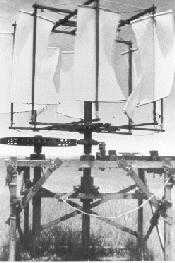4. THE GARDEN OF THE AMERICANS
Two years ago, when I came to Timbuktu for the first time, I heard about a garden in the desert that American missionaries had made, 10 km from the city, irrigating the sand with the groundwater pulled up with wind pumps.
Their story inspired me to bring windmills to Timbuktu. So I went to see for myself what had been done and I discovered an oasis, where fruit trees and vegetables of all kinds grew. I learned later that all the vegetables in Timbuktu market come from there.
I asked the Americans how much their windmills cost and where to buy them but they replied strongly advising me not to use them. The water of the region is sandy they said and the submerged part of the pump is damaged very quickly. This means you have to pull the submerged part of the pump and all the 100 meters of piping out of the well every 6 months, to change the worn parts. Their two wind pumps were not even in operation and the pumping was done with diesel engine pumps.
The first one was knocked down by the wind and is now broken.
The blades of the second one are flailing around helplessly in the wind and the pump is missing.
They then took me to see their well where they had installed the prototype of the “pump of the future” of Timbuktu (in their opinion). It was a rope with discs that passed through a tube to make the water rise. “Everything is made with local materials,” the proud inventor told me.
He gave me a demonstration, starting with turning a large crank. After 3 minutes he had raised a few litres of water but he was all red, out of breath and sweaty.
I didn’t take pictures because he showed me his mechanism under an oath of secrecy (fearing imitation).
The Flintstone pump
Maybe his pump does have some advantages over modern mechanics, but the problem is not the pump. The problem in such a poor country is the cost of petrol and diesel, in Mali a litre of diesel costs the equivalent of a worker’s daily wage. The windmill is capable of spinning its antediluvian pump for free in exactly the same way as the mechanical pumps, so why aren’t windmills recommended?
Why do they advise me against them when this is the obvious road to abundant free water?
Actually, there would not even be a problem with sand in the water. They had it because they chose to drill 100m deep (and the missionary is very proud of this depth) instead of making a large diameter, with 25 meter well and a high flow (11 m3/hour). With this kind of well, the water is filtered by a column of gravel and quietly decants, harnessed with a wind pump that pulls a maximum of 400 litres per hour. That way harmful sand never actually gets to the pump.
It seems they really don’t want to be imitated when they do something they believe to be useful, and I don’t understand why. Actually, I do not understand even why pump windmills haven’t been installed everywhere in the region and I do not understand why the little agriculture that is cultivated is only done along the river 20 km away.
The whole Timbuktu region sits on a freshwater ocean at a depth of only 20 meters, an inexhaustible reserve that is constantly being renewed, and fed by the Niger River.
Timbuktu Farming
Here, the wind blows all year round, except for two hours early in the morning. Why pay for diesel for pumps when energy is free? America built its agriculture on windmills a hundred years ago!
The manufacture and maintenance of a windmill is much less complicated than the manufacture and maintenance of a diesel engine. This is what is called pre-industrial technology. Indeed, the first pumping windmills were built in Persia 1200 years ago.
Reproduction of a Persian Windmill
What’s more, the sand of this region is such that everything that is planted in it grows, if it is watered…

Cabbages, tomatoes, mint and onions, mangos and apples…
Just behind the trees that border the garden, at the top of the photograph, the arid sand where only thorns grow.
To summarize, pumping windmills are capable of transforming Timbuktu and the whole region into a green oasis, giving it back the abundance, wealth and prosperity of the past. It is not difficult to understand, but rather I wonder what evil magic has prevented men so far from setting up windmills everywhere, and prevented Timbuktu from being reborn from its sand.
Is it that my idea of free water for all goes against the interest of the company that sells it to the people here?
Previouse episode: Back to Timbuktu Next episode: The orchards of Timbuktu

























Reclaiming the desert and turning it into gardens and orchards is truly a wonderful thing. I’ve seen areas in morocco that have a similar look. Water is the key. These farmers deserve tremendous respect. Maybe some of the new drip techniques for forming will help save these farmers backs. They should put up a go fund me page to help them get tubing to carry the water to their plots. The fringe of the Sahara is waiting to be reclaimed.